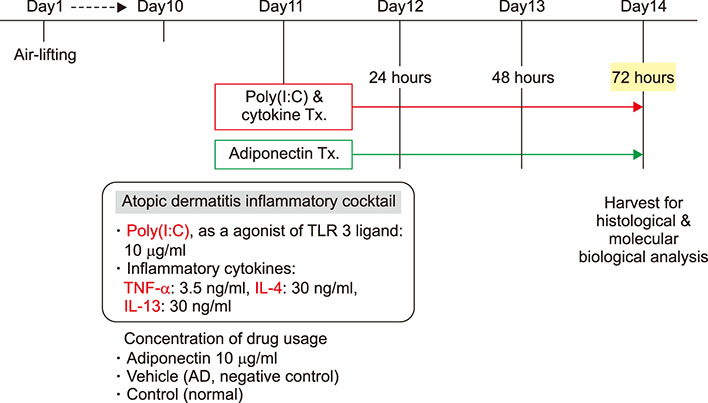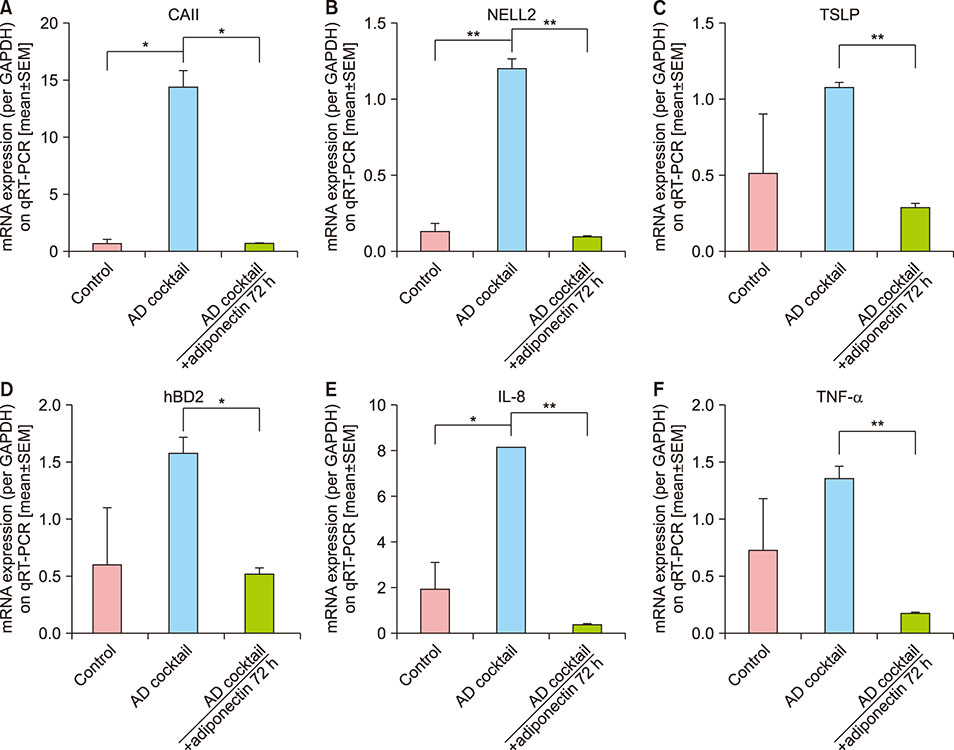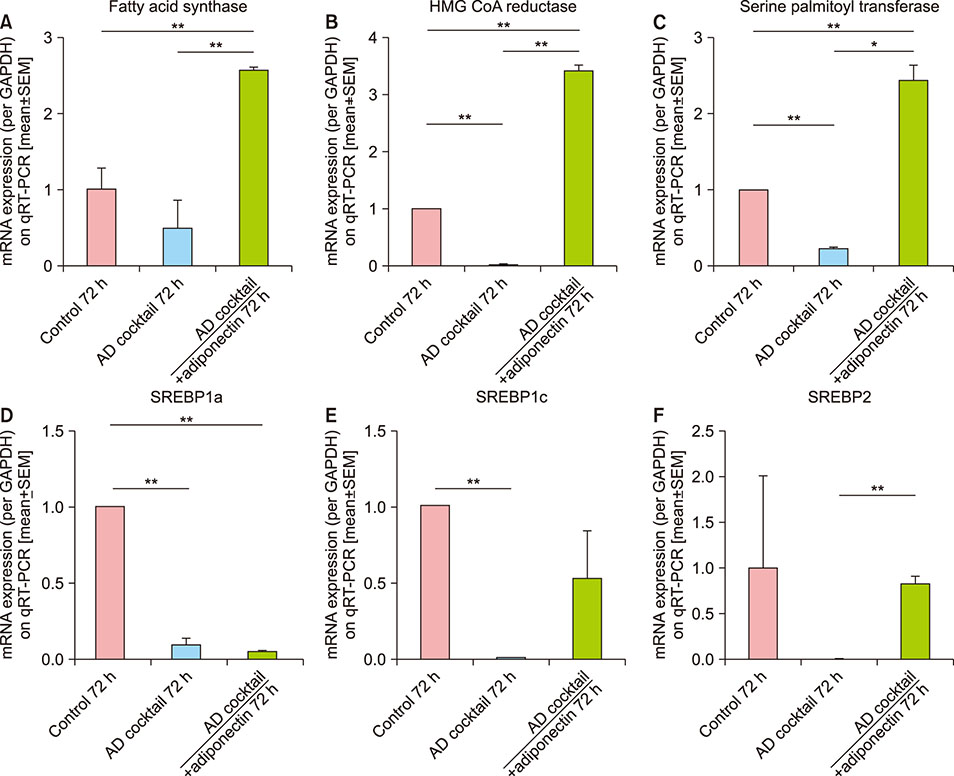Ann Dermatol.
2019 Apr;31(2):186-195. 10.5021/ad.2019.31.2.186.
Adiponectin Attenuates the Inflammation in Atopic Dermatitis-Like Reconstructed Human Epidermis
- Affiliations
-
- 1Department of Dermatology, Dankook University College of Medicine, Cheonan, Korea. zamoo97@naver.com
- 2Department of Dermatology, Chungnam National University College of Medicine, Daejeon, Korea.
- 3Department of Dermatology, Chung-Ang University Hospital, Seoul, Korea.
- KMID: 2439064
- DOI: http://doi.org/10.5021/ad.2019.31.2.186
Abstract
- BACKGROUND
Atopic dermatitis (AD) is a chronic disorder, with a vicious cycle of repetitive inflammation and deterioration of the epidermal barrier function. Adiponectin, an adipokine, has anti-inflammatory effects on various metabolic and inflammatory disorders. Recently, its level was found to be reduced in serum and tissue samples from AD patients.
OBJECTIVE
We aimed to investigate the effects of adiponectin on epidermal inflammation and barrier structures in AD skin.
METHODS
A three-dimensional in vitro epidermal equivalent model mimicking AD was obtained by adding an inflammatory substance cocktail to normal human epidermal equivalents (HEEs). The expression of epidermal differentiation markers, primary inflammatory mediators, and lipid biosynthetic enzymes was compared between adiponectintreated AD-HEEs, untreated control AD-HEEs, and normal HEEs.
RESULTS
Adiponectin co-treatment 1) inhibited the increase in mRNA expression of major inflammatory mediators (carbonic anhydrase II, neuron-specific NEL-like protein 2, thymic stromal lymphopoietin, interleukin-8, tumor necrosis factor-alpha, and human beta-defensin-2) from keratinocytes in AD-inflammatory HEEs, 2) enhanced the expression of lipid biosynthetic enzymes (fatty acid synthase, HMG CoA reductase, and serine-palmitoyl transferase), and 3) promoted the expression of differentiation factors, especially filaggrin. We also found that the expression of adiponectin receptor-1 and -2 decreased in the epidermis of chronic AD lesion.
CONCLUSION
Activation of the adiponectin pathway is expected to enhance epidermal differentiation and barrier function as well as attenuate inflammatory response to AD as a therapeutic approach.
MeSH Terms
-
Adipokines
Adiponectin*
Antigens, Differentiation
Dermatitis, Atopic
Epidermis*
Humans*
Hydroxymethylglutaryl CoA Reductases
In Vitro Techniques
Inflammation*
Interleukin-8
Keratinocytes
RNA, Messenger
Skin
Tumor Necrosis Factor-alpha
Adipokines
Adiponectin
Antigens, Differentiation
Hydroxymethylglutaryl CoA Reductases
Interleukin-8
RNA, Messenger
Tumor Necrosis Factor-alpha
Figure
Reference
-
1. Elias PM, Wakefield JS. Mechanisms of abnormal lamellar body secretion and the dysfunctional skin barrier in patients with atopic dermatitis. J Allergy Clin Immunol. 2014; 134:781.e1–791.e1.
Article2. Berdyshev E, Goleva E, Bronova I, Dyjack N, Rios C, Jung J, et al. Lipid abnormalities in atopic skin are driven by type 2 cytokines. JCI Insight. 2018; 3:98006.
Article3. Matsumura S, Terao M, Murota H, Katayama I. Th2 cytokines enhance TrkA expression, upregulate proliferation, and downregulate differentiation of keratinocytes. J Dermatol Sci. 2015; 78:215–223.
Article4. Ong PY, Ohtake T, Brandt C, Strickland I, Boguniewicz M, Ganz T, et al. Endogenous antimicrobial peptides and skin infections in atopic dermatitis. N Engl J Med. 2002; 347:1151–1160.
Article5. Bernard FX, Morel F, Camus M, Pedretti N, Barrault C, Garnier J, et al. Keratinocytes under fire of proinflammatory cytokines: bona fide innate immune cells involved in the physiopathology of chronic atopic dermatitis and psoriasis. J Allergy (Cairo). 2012; 2012:718725.
Article6. Rouaud-Tinguely P, Boudier D, Marchand L, Barruche V, Bordes S, Coppin H, et al. From the morphological to the transcriptomic characterization of a compromised three-dimensional in vitro model mimicking atopic dermatitis. Br J Dermatol. 2015; 173:1006–1014.
Article7. Jiang WG, Sanders AJ, Ruge F, Harding KG. Influence of interleukin-8 (IL-8) and IL-8 receptors on the migration of human keratinocytes, the role of PLC-γ and potential clinical implications. Exp Ther Med. 2012; 3:231–236.
Article8. Jung YR, Lee JH, Sohn KC, Lee Y, Seo YJ, Kim CD, et al. Adiponectin signaling regulates lipid production in human sebocytes. PLoS One. 2017; 12:e0169824.
Article9. Ohashi K, Shibata R, Murohara T, Ouchi N. Role of anti-inflammatory adipokines in obesity-related diseases. Trends Endocrinol Metab. 2014; 25:348–355.
Article10. Yamauchi T, Kadowaki T. Adiponectin receptor as a key player in healthy longevity and obesity-related diseases. Cell Metab. 2013; 17:185–196.
Article11. Kadowaki T, Yamauchi T, Okada-Iwabu M, Iwabu M. Adiponectin and its receptors: implications for obesity-associated diseases and longevity. Lancet Diabetes Endocrinol. 2014; 2:8–9.
Article12. Jin T, Kim MJ, Heo WI, Park KY, Choi SY, Lee MK, et al. Adiponectin corrects premature cellular senescence and normalizes antimicrobial peptide levels in senescent keratinocytes. Biochem Biophys Res Commun. 2016; 477:678–684.
Article13. Cnop M, Havel PJ, Utzschneider KM, Carr DB, Sinha MK, Boyko EJ, et al. Relationship of adiponectin to body fat distribution, insulin sensitivity and plasma lipoproteins: evidence for independent roles of age and sex. Diabetologia. 2003; 46:459–469.
Article14. Lago F, Dieguez C, Gómez-Reino J, Gualillo O. Adipokines as emerging mediators of immune response and inflammation. Nat Clin Pract Rheumatol. 2007; 3:716–724.
Article15. van Stijn CM, Kim J, Barish GD, Tietge UJ, Tangirala RK. Adiponectin expression protects against angiotensin II-mediated inflammation and accelerated atherosclerosis. PLoS One. 2014; 9:e86404.
Article16. Fasshauer M, Blüher M. Adipokines in health and disease. Trends Pharmacol Sci. 2015; 36:461–470.
Article17. Shibata S, Tada Y, Hau CS, Mitsui A, Kamata M, Asano Y, et al. Adiponectin regulates psoriasiform skin inflammation by suppressing IL-17 production from γδ-T cells. Nat Commun. 2015; 6:7687.
Article18. Campanati A, Ganzetti G, Giuliodori K, Marra M, Bonfigli A, Testa R, et al. Serum levels of adipocytokines in psoriasis patients receiving tumor necrosis factor-α inhibitors: results of a retrospective analysis. Int J Dermatol. 2015; 54:839–845.
Article19. Prussick RB, Miele L. Nonalcoholic fatty liver disease in patients with psoriasis: a consequence of systemic inflammatory burden? Br J Dermatol. 2018; 179:16–29.
Article20. Danso MO, van Drongelen V, Mulder A, van Esch J, Scott H, van Smeden J, et al. TNF-α and Th2 cytokines induce atopic dermatitis-like features on epidermal differentiation proteins and stratum corneum lipids in human skin equivalents. J Invest Dermatol. 2014; 134:1941–1950.
Article21. Kamsteeg M, Bergers M, de Boer R, Zeeuwen PL, Hato SV, Schalkwijk J, et al. Type 2 helper T-cell cytokines induce morphologic and molecular characteristics of atopic dermatitis in human skin equivalent. Am J Pathol. 2011; 178:2091–2099.
Article22. Nomura I, Gao B, Boguniewicz M, Darst MA, Travers JB, Leung DY. Distinct patterns of gene expression in the skin lesions of atopic dermatitis and psoriasis: a gene microarray analysis. J Allergy Clin Immunol. 2003; 112:1195–1202.
Article23. Kamsteeg M, Zeeuwen PL, de Jongh GJ, Rodijk-Olthuis D, Zeeuwen-Franssen ME, van Erp PE, et al. Increased expression of carbonic anhydrase II (CA II) in lesional skin of atopic dermatitis: regulation by Th2 cytokines. J Invest Dermatol. 2007; 127:1786–1789.
Article24. Kamsteeg M, Jansen PA, van Vlijmen-Willems IM, van Erp PE, Rodijk-Olthuis D, van der Valk PG, et al. Molecular diagnostics of psoriasis, atopic dermatitis, allergic contact dermatitis and irritant contact dermatitis. Br J Dermatol. 2010; 162:568–578.
Article25. van den Bogaard EH, Tjabringa GS, Joosten I, Vonk-Bergers M, van Rijssen E, Tijssen HJ, et al. Crosstalk between keratinocytes and T cells in a 3D microenvironment: a model to study inflammatory skin diseases. J Invest Dermatol. 2014; 134:719–727.
Article26. Yokota T, Oritani K, Takahashi I, Ishikawa J, Matsuyama A, Ouchi N, et al. Adiponectin, a new member of the family of soluble defense collagens, negatively regulates the growth of myelomonocytic progenitors and the functions of macrophages. Blood. 2000; 96:1723–1732.
Article27. Yamaguchi N, Argueta JG, Masuhiro Y, Kagishita M, Nonaka K, Saito T, et al. Adiponectin inhibits Toll-like receptor family-induced signaling. FEBS Lett. 2005; 579:6821–6826.
Article28. Ohashi K, Parker JL, Ouchi N, Higuchi A, Vita JA, Gokce N, et al. Adiponectin promotes macrophage polarization toward an anti-inflammatory phenotype. J Biol Chem. 2010; 285:6153–6160.
Article29. Summer R, Little FF, Ouchi N, Takemura Y, Aprahamian T, Dwyer D, et al. Alveolar macrophage activation and an emphysema-like phenotype in adiponectin-deficient mice. Am J Physiol Lung Cell Mol Physiol. 2008; 294:L1035–L1042.
Article30. Okamoto Y, Folco EJ, Minami M, Wara AK, Feinberg MW, Sukhova GK, et al. Adiponectin inhibits the production of CXC receptor 3 chemokine ligands in macrophages and reduces T-lymphocyte recruitment in atherogenesis. Circ Res. 2008; 102:218–225.
Article31. Komura N, Maeda N, Mori T, Kihara S, Nakatsuji H, Hirata A, et al. Adiponectin protein exists in aortic endothelial cells. PLoS One. 2013; 8:e71271.
Article32. Shibata R, Sato K, Pimentel DR, Takemura Y, Kihara S, Ohashi K, et al. Adiponectin protects against myocardial ischemia-reperfusion injury through AMPK- and COX-2-dependent mechanisms. Nat Med. 2005; 11:1096–1103.
Article33. Bai F, Zheng W, Dong Y, Wang J, Garstka MA, Li R, et al. Serum levels of adipokines and cytokines in psoriasis patients: a systematic review and meta-analysis. Oncotarget. 2018; 9:1266–1278.
Article34. Sereflican B, Goksugur N, Bugdayci G, Polat M, Haydar Parlak A. Serum visfatin, adiponectin, and tumor necrosis factor alpha (TNF-α) levels in patients with psoriasis and their correlation with disease severity. Acta Dermatovenerol Croat. 2016; 24:13–19.35. Han B, Wu WH, Bae JM, Son SJ, Lee JH, Han TY. Serum leptin and adiponectin levels in atopic dermatitis (AD) and their relation to disease severity. J Am Acad Dermatol. 2016; 75:629–631.
Article36. Plager DA, Leontovich AA, Henke SA, Davis MD, McEvoy MT, Sciallis GF 2nd, et al. Early cutaneous gene transcription changes in adult atopic dermatitis and potential clinical implications. Exp Dermatol. 2007; 16:28–36.
Article37. Guttman-Yassky E, Suárez-Fariñas M, Chiricozzi A, Nograles KE, Shemer A, Fuentes-Duculan J, et al. Broad defects in epidermal cornification in atopic dermatitis identified through genomic analysis. J Allergy Clin Immunol. 2009; 124:1235–1244.
Article38. Sood A, Shore SA. Adiponectin, leptin, and resistin in asthma: basic mechanisms through population studies. J Allergy (Cairo). 2013; 2013:785835.
Article39. Dogru M, Ozde S, Aktas A, Yuksel Karatoprak E. The adiponectin levels and asthma control in non-obese children with asthma. J Asthma. 2015; 52:772–776.
Article40. de Lima Azambuja R, da Costa Santos Azambuja LS, Costa C, Rufino R. Adiponectin in asthma and obesity: protective agent or risk factor for more severe disease? Lung. 2015; 193:749–755.
Article41. Jin T, Park KY, Seo SJ. Adiponectin upregulates filaggrin expression via SIRT1-mediated signaling in human normal keratinocytes. Ann Dermatol. 2017; 29:407–413.
Article42. Shibata S, Tada Y, Asano Y, Hau CS, Kato T, Saeki H, et al. Adiponectin regulates cutaneous wound healing by promoting keratinocyte proliferation and migration via the ERK signaling pathway. J Immunol. 2012; 189:3231–3241.
Article
- Full Text Links
- Actions
-
Cited
- CITED
-
- Close
- Share
- Similar articles
-
- Significance of Skin Barrier Dysfunction in Atopic Dermatitis
- Measurement of Atopic Dermatitis Disability
- CCL1, Specific Manifestation in Lesional Atopic Skin
- A Case of Hereditary Anhidrotic Ectodermal Dysplasia
- Serum IgE Level in Patients of Atopic Dermatitis and Atopic Dermatitis with Molluscum Contagiosum







